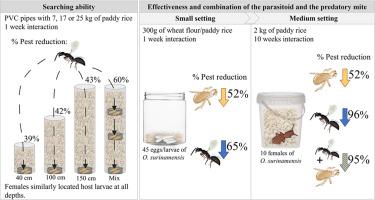当前位置:
X-MOL 学术
›
J. Stored Prod. Res.
›
论文详情
Our official English website, www.x-mol.net, welcomes your
feedback! (Note: you will need to create a separate account there.)
Cephalonomia tarsalis (Hymenoptera: Bethylidae) for the control of the sawtoothed grain beetle, either alone or in combination with the predatory mite Blattisocius tarsalis
Journal of Stored Products Research ( IF 2.7 ) Pub Date : 2024-01-19 , DOI: 10.1016/j.jspr.2024.102250 Lidia del Arco , Jordi Riudavets , Cristina Castañé
Journal of Stored Products Research ( IF 2.7 ) Pub Date : 2024-01-19 , DOI: 10.1016/j.jspr.2024.102250 Lidia del Arco , Jordi Riudavets , Cristina Castañé

|
The sawtoothed grain beetle (L.) (Coleoptera: Silvanidae) is an important pest of stored cereals. Due to the phasing out of many active compounds registered as insecticides and the occurrence of insect resistance to the remaining active compounds, it is crucial to develop alternative pest control strategies, such as the use of natural enemies. In this study, we evaluated the ability of (Ashmead) (Hymenoptera: Bethylidae), a specialised larval ectoparasitoid, to locate and parasitize in vertical PVC pipes 20 cm in diameter filled with 7–26 kg of paddy rice. The parasitoid was able to move through the rice and reduce pest emergence up to 60% at depths of 40, 100, and 150 cm, even when larvae were offered simultaneously at all three depths. Since most of the pest populations are found in the upper layer of 1 m of the grain piles, this result suggests that the parasitoid would be able to locate and parasitize the pest within the stored paddy rice piles. We also evaluated the possibility of complementing pest reduction by the parasitoid with the aid of the egg-predatory mite (Berlese) (Mesostigmata: Ascidae). When each natural enemy was offered its target pest instar for one week, both were able to reduce the pest similarly by 52–65%. When they were released in 2 kg of paddy rice with 10 females for 10 weeks, the parasitoid achieved higher pest reduction (96%) than the predatory mite (42%). The pest reduction obtained by combining both natural enemies did not improve the efficacy of the parasitoid, suggesting that the parasitoid alone can be an effective alternative to maintain the beetle populations under control.
中文翻译:

Cephalonomia tarsalis(膜翅目:Bethidae)用于控制锯齿谷甲虫,单独或与捕食性螨 Blattisocius tarsalis 组合使用
锯齿谷甲虫(L.)(鞘翅目:林科)是储存谷物的重要害虫。由于许多登记为杀虫剂的活性化合物被逐步淘汰,并且昆虫对剩余的活性化合物产生了抗药性,因此开发替代害虫防治策略(例如使用天敌)至关重要。在这项研究中,我们评估了 Ashmead(膜翅目:Bethlidae)(一种特殊的外寄生物幼虫)在直径 20 厘米、装有 7-26 公斤稻米的垂直 PVC 管道中定位和寄生的能力。即使在所有三个深度同时提供幼虫,寄生蜂也能够穿过水稻,在 40、100 和 150 厘米的深度处将害虫的出现率减少高达 60%。由于大多数害虫种群存在于粮堆的上层 1 m 处,因此该结果表明寄生蜂能够在储存的稻堆内定位并寄生害虫。我们还评估了寄生蜂在卵捕食螨(Berlese)(Mesostigmata:Ascidae)的帮助下补充害虫减少的可能性。当向每种天敌提供其目标害虫龄期一周时,两者都能将害虫数量同样减少 52-65%。当将它们与 10 只雌性一起释放在 2 公斤稻米中 10 周时,寄生蜂的害虫减少量 (96%) 高于捕食螨 (42%)。通过结合两种天敌获得的害虫减少并没有提高寄生蜂的功效,这表明单独的寄生蜂可以成为控制甲虫种群的有效替代方案。
更新日期:2024-01-19
中文翻译:

Cephalonomia tarsalis(膜翅目:Bethidae)用于控制锯齿谷甲虫,单独或与捕食性螨 Blattisocius tarsalis 组合使用
锯齿谷甲虫(L.)(鞘翅目:林科)是储存谷物的重要害虫。由于许多登记为杀虫剂的活性化合物被逐步淘汰,并且昆虫对剩余的活性化合物产生了抗药性,因此开发替代害虫防治策略(例如使用天敌)至关重要。在这项研究中,我们评估了 Ashmead(膜翅目:Bethlidae)(一种特殊的外寄生物幼虫)在直径 20 厘米、装有 7-26 公斤稻米的垂直 PVC 管道中定位和寄生的能力。即使在所有三个深度同时提供幼虫,寄生蜂也能够穿过水稻,在 40、100 和 150 厘米的深度处将害虫的出现率减少高达 60%。由于大多数害虫种群存在于粮堆的上层 1 m 处,因此该结果表明寄生蜂能够在储存的稻堆内定位并寄生害虫。我们还评估了寄生蜂在卵捕食螨(Berlese)(Mesostigmata:Ascidae)的帮助下补充害虫减少的可能性。当向每种天敌提供其目标害虫龄期一周时,两者都能将害虫数量同样减少 52-65%。当将它们与 10 只雌性一起释放在 2 公斤稻米中 10 周时,寄生蜂的害虫减少量 (96%) 高于捕食螨 (42%)。通过结合两种天敌获得的害虫减少并没有提高寄生蜂的功效,这表明单独的寄生蜂可以成为控制甲虫种群的有效替代方案。

















































 京公网安备 11010802027423号
京公网安备 11010802027423号